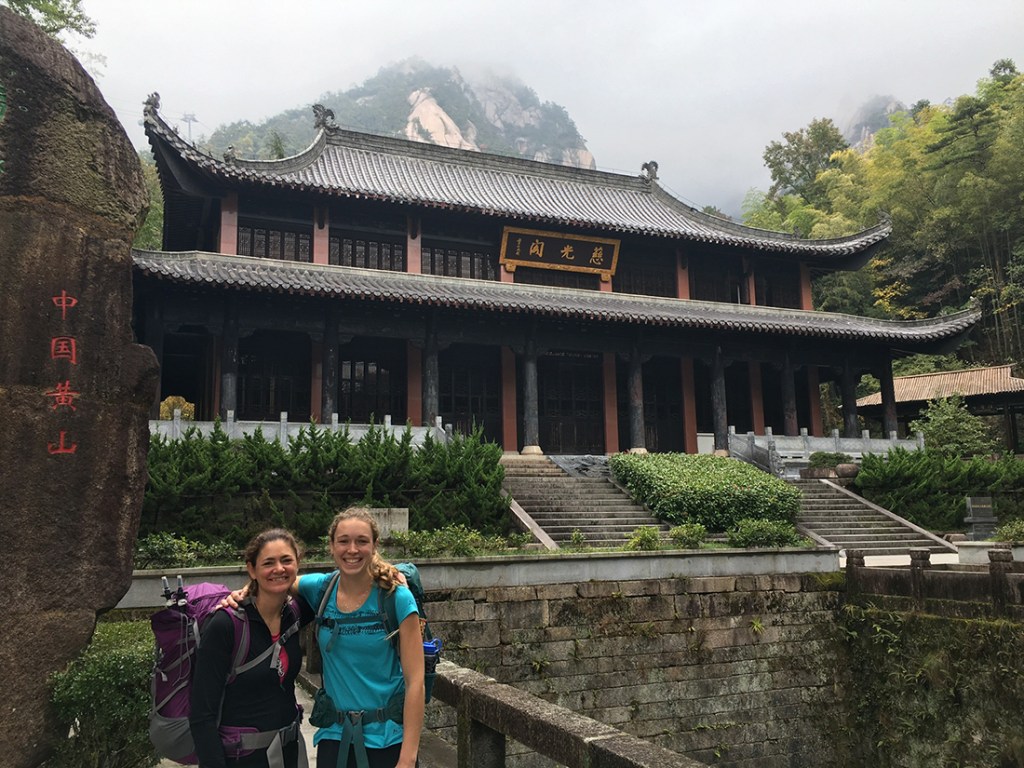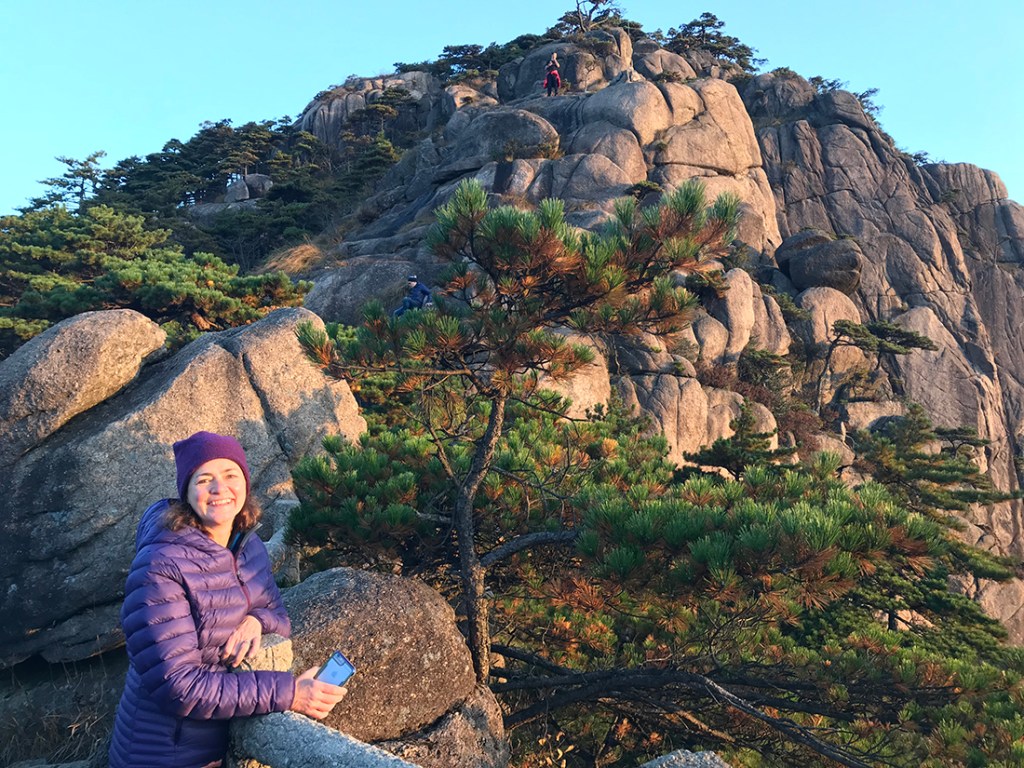The tour groups’ matching hats bobbed rhythmically up the steps etched into the granite cliff. A guide’s words blared across the valley from the microphone speaker on her belt. One couple broke from the herd and raced to a viewpoint for a selfie, then ran to the next view for another. A man talked loudly on his phone. This was Huangshan at peak tourist season.
My partner and I had come to China’s Mount Huangshan, a popular spiritual destination, to walk where my mom first explored more than 30 years ago. As we hiked, my mom pointed out pagodas that she’d sat in for hours when she was our age and buildings that were new since her last visit. Still recovering from foot surgery, she didn’t remember the walk being so long.
When we’d invited my mom to come, she’d asked which destinations we were considering. Shanghai for a day, we told her, then Huangshan, then Guilin. “You’re going to go all the way to China and not see the wall?” she’d asked, confused. It perplexed her, but to me, it made perfect sense. I wanted to see the mountains.
Mount Huangshan
Huangshan, in Anhui province, is known for its soaring granite peaks and jagged spires that puncture the clouds in a dramatic declaration of Mother Nature’s beauty. There is an entire school of painting named after it, called the Anhui or Xin’an school of painting, inspired by poets and artists like Li Bai and Shi Tao. Today, the mountain is still the spiritual retreat of painters and poets, albeit, a more popular and crowded one.

The author and her mother, Dawn, saddle up at the base of Huangshan.
I generally try to avoid popular parks and forests, preferring solitude to the best view or the perfect photo. So, it surprised me when I visited Huangshan and wasn’t entirely bothered by the crowds. Normally, I’d be sour—the kind of mood where you make up your mind to be mad and stay mad. But the views didn’t feel lessened by the crowds, but instead, seemed to justify them; the sights were genuinely jaw-dropping.
The Importance of Shared Experiences
The first time my mom visited Huangshan—when she was 19—the crowds didn’t exist.
It was 1985, shortly after China opened to foreign visitors. She remembers hiking entire stretches of trail without seeing anyone except an old woman selling medicinal mushrooms. Growing up, she had experienced nature through gardening and family camping and canoeing trips, so Huangshan’s mountainous landscape was new and intoxicating.
My mom was studying Chinese in Nanjing when she visited Huangshan. It was the summer after her sophomore year in college, a year that had left her reeling from personal events. Disillusioned with the faith she had grown up with, she was just beginning to learn about nature-based spirituality. Huangshan was far from the university, far from home and far from a belief system in which she felt trapped. It was a breath of fresh air.
Now, more than 30 years later, my mom and I passed dozens of other tourists as we climbed the stairs in the predawn chill. When we reached the first lookout—which was packed with people—I checked my watch. There was still time to press on.
At a viewpoint farther up the trail, we crouched beneath the lowest branches of a Huangshan pine, a species endemic to the region, on the edge of a cliff. The sky lightened into a soft pink, and when the sun crested over the ridge, it spilled onto my mom’s smiling face.

Dawn Karlson enjoys the sunlight near the top of Huangshan.
More than 30 years ago, she had watched the same sunrise with her school friends. This time, she hoped I’d feel the way she did all those years ago—full of wonder. And I did, but maybe not because of the view. I felt like I was seeing her for the first time.
My mom and I had hiked together before, but we’d never traveled together internationally or undertaken a shared goal as physically demanding as hiking Huangshan. Watching the sun rise that morning, muscles exhausted from the previous day, I felt connected to her in a new way. I was able to understand her past and empathize with the struggles she had faced as a young woman in a way I hadn’t before. I saw the myriad dimensions of her person—explorer, spiritual practitioner, friend—not just mother.
And my role was not just daughter; I was a student of this woman and this place.
The Huangshan pines grew at almost impossible angles out of the granite, and the mist moved up the rock faces and through the valleys in surprising ways. This was the center of my mom’s spiritual geography. She didn’t know why exactly, but many of her formative spiritual experiences had happened in this place.
Walking up the stairs all day and then back down again was like a pilgrimage. Everyone, from babies to elderly people, shared the journey together.
On our recent trip, my mom didn’t enjoy the crowds, but she didn’t mind them. Sure, some people were just there for the selfies, but there were also families picnicking together, laughing and staring at the landscape with wonder. “You can allow yourself to be swept away by the conditions and the crowds,” my mom said, “but it’s a spiritual place. Period.”
Transcending the Roles of Mother and Daughter
The following day, after meandering along a recently built concrete trail that juts out of the granite cliffs in a seemingly impossible feat of engineering, we began our descent from Huangshan. Halfway down the mountain, we encountered the cable car. My mom’s foot was bothering her, and she wanted to ride down. I was enjoying the fresh air and wanted to continue walking. After a brief, tight-lipped exchange in which I suggested we split up and meet at the bottom, she decided to keep walking. The tension between us—two stubborn women—hung thick in the air.
Her ankle, weakened by several months of limited use, began to give out on nearly every step. She clung to my arm, and we descended slowly. My mom is quite independent—she’s used to being the one who supports others, not the one who receives support.
But at Huangshan, she had to lean on me. It was a new role for both of us: her, accepting help, and me, taking care of her.
It’s important to experience our most sacred landscapes alone. There’s a place for solitude and quiet reflection. But being alone isn’t always what we need. Sometimes, we need to be in a relationship with the place and the people we care about, at the same time.
Sometimes, we need to be in a relationship with the place and the people we care about, at the same time.
In her book marking the 50th anniversary of Edward Abbey’s Desert Solitaire, Amy Irvine writes, “Going it alone is a failure of contribution and compassion, and this is what drains the world dry. Ultimately, this is why I am here today: to invite [Abbey] to join me in asking [his] followers to do away with their rugged individualism … by nature, we are a cabal. A group gathered around a panoramic vision.”
My vision for this trip was to experience Huangshan through my mom’s eyes, but what emerged was not a singular lens. Like the yin and the yang, or the clouds and the mountains, I saw the evolving tension holding mother and daughter, our roles and our understanding of each other changing with each step.
